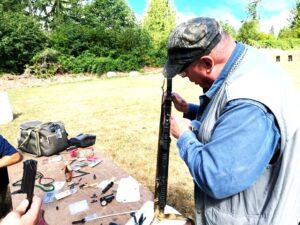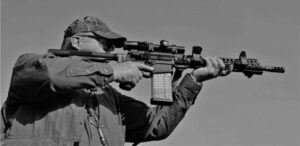Farnam’s Defensive Urban Rifle (DUR) course is designed for students who have basic rifle skills. If you show up without the ability to efficiently change a magazine and hit an A zone at 40 yards, you will not get maximum benefit from the class. Take a basic rifle class first. Most of the shooters in my class were graduates of the excellent Firearms Academy of Seattle pipeline and it showed in their skills.
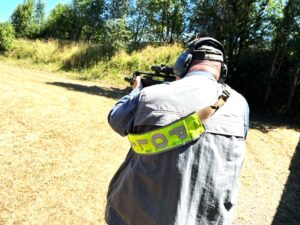
Shooters learn to operate effectively at distances that mimic where they live, the distance between the middle of the street to their front door. Whether you’re interested in home defense with a rifle or want to work on movement and practical rifle handling, this course will take you to from basic to tactical.
Farnam says “Training occurs when you fail” and he provides plenty of opportunities to get great training. I had the opportunity to attend John Farnam’s famous Defensive Urban Rifle course, hosted by the Firearms Academy of Seattle (FAS) located in beautiful rural Lewis County, Washington. https://firearmsacademy.com/
The Firearms Academy of Seattle is a private facility. You may not enter unless you are part of a class. Their ranges are on a par with any range in the country and is an excellent training venue. FAS is a close-knit community of students and trainers with the mission of building thinking shooters. The owner and senior trainer at FAS, Belle McCormack, kindly allowed me to camp on site over the weekend. This made the whole experience much more pleasant.
Philosophy and Training
Rather than give you a list of drills, I want to share Farnam’s thinking and the fundamental truths behind his teaching. You can read the drills online, but without context you won’t get the main benefits.
The classes are kept small. My class had seven shooters and an assistant instructor, Chris Harold, from Firearms Academy of Seattle. Most of the drills were run with one shooter at a time. With the small class size and two instructors, drills went quickly and stayed safe. Each shooter got plenty of individual feedback.
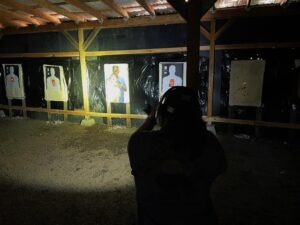
Part of this class is learning to live with a rifle. Slings are mandatory, we were required to have our rifles with us at all times. If things are bad enough to need an urban rifle, you should be comfortable carrying one around for two days.
Even though this is a rifle class, handguns were carried and used in several drills. If you are not comfortable with weapons transitions and handgun skills, get training before this class. Farnham runs a hot range. There is no ready command on any drill. You are expected to keep your guns loaded and ready.
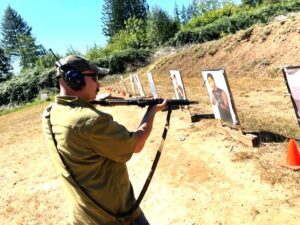
DUR drills emphasize weapons retention. He teaches a flat ready position with the stock flat on the shoulder. Placing the stock on top of the shoulder shortens overall length for a bit of a compressed ready in close quarters.
Most of the targets in the drills were photo realistic targets. Threat targets were armed and threating. This was important as no-shoot bystander targets were used both day and night. This provided some realistic ambiguity for aiming points and scoring hits using anatomy.
Throughout all the drills, Farnam demands 80% effective hits. Any student with less than an 80% accuracy was admonished to focus on the basics and get their hits. Emphasis was placed on movement and keeping the head up and in the fight. Farnam is insistent that you maintain situational awareness and look around for the next threat or friendly. Each target is checked and every round is accounted for in every drill.
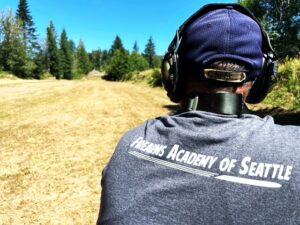
Using the amazing rifle range complex at FAS, we had reactive steel targets available out to 625 yards. DUR took us out to 225 yards, about the practical effective range of a .223 carbine. We engaged multiple targets with various positions and levels of support.
The result of all these drills is each shooter finding what Farnam calls their “Goldilocks zone”. The term refers to the fairy tale heroine who sought porridge, which was just right, neither too hot nor too cold. In Defensive Urban Rifle, it refers to knowing ones’ abilities and their capacity to produce them on demand. Shooters should strive to constantly improve their speed and accuracy rather than engage in comfortable drills where they are competent.
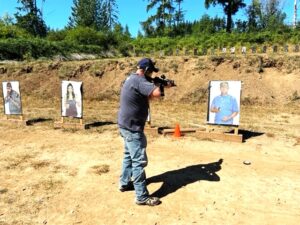
DUR is about taking you out of your comfort zone and stressing basic skills in awkward circumstances. This is not the kind of feel-good class where you mag dump in a line drill with thirty other shooters. You will be watched and coached on each round. If you fail, you are given constructive suggestions and another opportunity to succeed.
The culmination of the class is the rifle test. Farnam’s test is well known and simple. I recommend you use it to assess your readiness for the DUR class. You engage five IDPA/IPSC size targets at forty meters, with five rounds in 22 seconds. One A zone hit each target, no misses or second shots allowed. The test starts as you are moving along the 40-meter line.
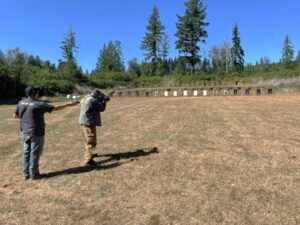
Starting position is rifle slung, safety on while moving laterally and scanning. On the signal you must move off-line before the first shot. Sometime between the second and fifth shots you must move twice more. Going from standing to kneeling or prone will count as a move but any move up does not count. Movement makes the test deceptively difficult. Moving with the finger in the trigger guard is an immediate disqualification. Passing score is five A zone hits with all the right moves in 22 seconds.
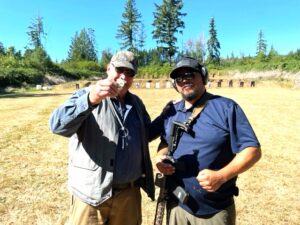
You will be presented with several opportunities to test. When a student passes the test, John presents them with a Defense Training International rifle pin. Three of the students in my class passed the test and got the pin.
Equipment
Whatever you bring, be sure you know how to use it. Red dot sights are fast at close ranges and my preferred optic. At close ranges an iron sighted rifle will work very well with a flash sight picture. The red dot earns its money out to 200 meters and at night. It is much faster to pick up than iron sights and there is no sight alignment, just a dot superimposed on the target.
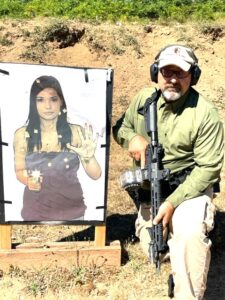
I used a SIG VTAC M400 (a 16-inch barrel AR carbine) with a Aimpoint Micro H2. This combination was ideal for close shooting. I added a Blue Force Vickers sling which proved invaluable for fast adjustment and a Inforce light for low light. I used KCI magazines including a fifty-round drum (this was an un-necessary capacity, I just wanted to see if it would run. Spoiler alert: it runs great). I had used all this equipment in training, and it all ran well in class.
One of our shooters had a 1×6 variable power scope. It was great at 250 yards, but he spent a lot of time on other drills changing power. The best bet in this class is to do most drills at one power and use it like a red dot. This is the strength of the variable power optic flexibility.
Your rifle should be able to run 500 rounds without breaking. Your gear should hold a handgun and your rifle magazines through the gamut of practical position shooting. Know where your rifle and ammo will hit from zero to 200 meters.
Here is my advice on preparation for Defensive Urban Rifle class:
Take a basic class from a professional outfit like Firearms Academy of Seattle BEFORE you show up for DUR – Don’t waste class time fumbling basics
Bring the best rifle and optics you can afford and an extra AR bolt or spare gun if you can – Don’t miss drills because of a broken gun
Bring tools to adjust your sights and batteries – Seems obvious, but many shooters don’t
Make sure you are zeroed and sure of your ammunition – if you aren’t zeroed with your ammo, the class will not demonstrate your skill
Bring extra ammunition for bonus training opportunities – We had the opportunity to shoot out to 500 yards on steel at lunch time
Bring clothes suitable for the weather – If you are too hot or too cold it is hard to learn
Bring drinks and snacks – You can’t learn much dehydrated and hungry
Use a pocket-sized notebook to take notes – You will never remember the little thigs unless you take notes
John Farnam is a master instructor and Defensive Urban Rifle is perhaps his best class. His company, Defense Training International, presents a wide variety of training. His website features the excellent DTI Operator video series. You can find it all at www.defense-training.com.
I also recommend you look at training with the Firearms Academy of Seattle. They have a variety of well-regarded guest instructors and their own solid curriculum of basic and advanced skills for all levels. Wherever you live, FAS is worth the trip.
About John Farnam
John Farnam is a Deputy Sheriff (Training Officer) for the Park County, Colorado and a decorated veteran of the Vietnam War. John is one of the top defensive firearms instructors teaching classes across the country. He has trained thousands of federal, state, and local law enforcement agency personnel, private security agencies.
A world-famous author and trainer, John Farnam has been a tremendous influence on shooting and self-defense for decades. His books, The Farnam Method of Defensive Hand gunning, Second Edition, The Farnam Method of Defensive Rifle and Shotgun Shooting, Second Edition and Guns and Warriors, Volume One have become the standard texts on the subjects.
I read his books as a new shooter, and I highly recommend them to you. He has also authored dozens of magazine articles, five books, written several handgun manuals, and produced numerous training videos.

